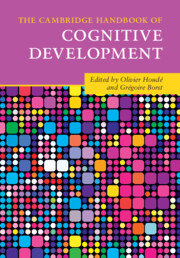Book contents
- The Cambridge Handbook of Cognitive Development
- The Cambridge Handbook of Cognitive Development
- Copyright page
- Contents
- Figures
- Tables
- Contributors
- Introduction
- Part I Neurobiological Constraints and Laws of Cognitive Development
- Part II Fundamentals of Cognitive Development from Infancy to Adolescence and Young Adulthood
- Part III Education and School-Learning Domains
- 25 Linking Cognitive Neuroscientific Research to Educational Practice in the Classroom
- 26 Literacy
- 27 Reasoning in Mathematical Development
- 28 Children’s Scientific Reasoning Skills in Light of General Cognitive Development
- 29 Working Memory Training
- 30 Interventions for Improving Executive Functions during Development
- 31 Curiosity-Driven Learning in Development
- 32 Neurocomputational Methods
- Index
- Plate Section (PDF Only)
- References
30 - Interventions for Improving Executive Functions during Development
Working Memory, Cognitive Flexibility, and Inhibition
from Part III - Education and School-Learning Domains
Published online by Cambridge University Press: 24 February 2022
- The Cambridge Handbook of Cognitive Development
- The Cambridge Handbook of Cognitive Development
- Copyright page
- Contents
- Figures
- Tables
- Contributors
- Introduction
- Part I Neurobiological Constraints and Laws of Cognitive Development
- Part II Fundamentals of Cognitive Development from Infancy to Adolescence and Young Adulthood
- Part III Education and School-Learning Domains
- 25 Linking Cognitive Neuroscientific Research to Educational Practice in the Classroom
- 26 Literacy
- 27 Reasoning in Mathematical Development
- 28 Children’s Scientific Reasoning Skills in Light of General Cognitive Development
- 29 Working Memory Training
- 30 Interventions for Improving Executive Functions during Development
- 31 Curiosity-Driven Learning in Development
- 32 Neurocomputational Methods
- Index
- Plate Section (PDF Only)
- References
Summary
Executive functions (EFs) comprise a set of cognitive skills harnessed for the regulation of behaviour and the pursuit of long-term goals. Sometimes referred to as cognitive control, this set of processes enables one to stay focused on a particular task and ignore distractions along the way (Diamond, 2013). There is some consensus that EFs can be decomposed into three core components, namely working memory, cognitive flexibility and inhibition (Miyake et al., 2000). Working memory (WM) allows the short-term retention and manipulation of information in mind (Baddeley, 1992); inhibitory control (IC) refers to the ability to suppress prepotent impulses and is also referred to as self-control or interference control (Logan et al., 1997); while cognitive flexibility (CF) is the ability to switch readily between different mental processes or task-demands (Eslinger & Grattan, 1993). These three EFs often operate jointly in a large variety of cognitive-development tasks. For the purposes of the present chapter, we also review the literature on attentional control (AC) (the ability to direct focus to the task at hand; Davidson et al., 2006).
- Type
- Chapter
- Information
- The Cambridge Handbook of Cognitive Development , pp. 623 - 643Publisher: Cambridge University PressPrint publication year: 2022



